|
My United States Paper Money Collection |

|
|
One Dollar | Two Dollar | Five Dollar | Ten Dollar | Twenty Dollar | Fifty Dollar | Hundred Dollar | Miscellaneous
|
One Dollar Bills |
|
Series 1886 One Dollar Silver Certificate

 
The Series 1886 $1 Silver Certificate was the first $1 Silver Certificate produced in America. It measures 7 3/8 by 3 1/8 inches and bears a red seal (as opposed to later Silver Certificates that all bore a blue seal). The obverse of the note bears a portrait of Martha Washington, which also gives it the distinction of being the only U.S. currency to bear the image of a non-allegorical female on the obverse. The obverse also bears the phrase, "THIS CERTIFIES THAT THERE HAS BEEN DEPOSITED IN THE TREASURY OF THE UNITED STATES ONE SILVER DOLLAR PAYABLE TO THE BEARER ON DEMAND WASHINGTON, D.C."
The reverse of the note states, "UNITED STATES SILVER CERTIFICATE" and displays a redemption clause that states, "THIS CERTIFICATE IS REDEEMABLE FOR CUSTOMS, TAXES AND ALL PUBLIC DUES, AND WHEN SO RECEIVED MAY BE REISSUED."
|
|
Series 1896 One Dollar Silver Certificate ("Educational")
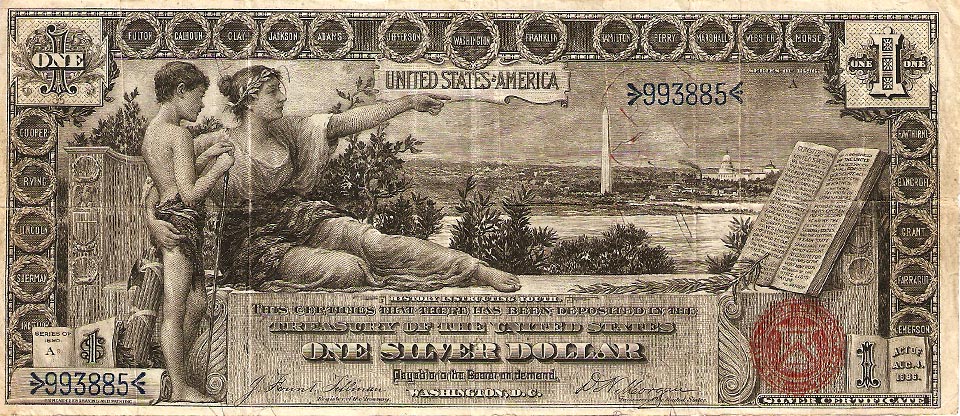
  
The Series 1896 One Dollar Silver Certificate is the first note of the famous Educational Series of 1896 -- considered the most artistically designed of all U.S. currency issues -- and reflects a time in American history when currency was not just money but also a work of art. The obverse of this large-size (7 3/8 by 3 1/8 inches) note is an engraving entitled "History Instructing Youth," with a view of the U.S. Capitol Building. Along the border, within wreaths, are the names of numerous great Americans. The obverse of this note also bears the phrase, "THIS CERTIFIES THAT THERE HAS BEEN DEPOSITED IN THE TREASURY OF THE UNITED STATES ONE SILVER DOLLAR PAYABLE TO THE BEARER ON DEMAND WASHINGTON, D.C."
The reverse features portraits of both George and Martha Washington, separated by the number "1" (which has led some people to joke that this is the "only one to ever come between George and Martha Washington"). Also displayed on the reverse is a redemption clause that states, "THIS CERTIFICATE IS REDEEMABLE FOR CUSTOMS, TAXES AND ALL PUBLIC DUES, AND WHEN SO RECEIVED MAY BE REISSUED."
|
|
Series 1899 One Dollar Silver Certificate ("Black Eagle")

  
The Series 1899 $1 Silver Certificate measures 7 3/8 by 3 1/8 inches and bears the distinctive blue seal and serial numbers that mark it as a genuine Silver Certificate. The obverse features an engraving of a black eagle clutching the American flag with Civil War leaders Ulysses S Grant and Abraham Lincoln sheltered by the eagle’s outstretched wings. The obverse of this note also bears the phrases, "THIS CERTIFIES THAT THERE HAS BEEN DEPOSITED IN THE TREASURY OF THE UNITED STATES ONE SILVER DOLLAR PAYABLE TO THE BEARER ON DEMAND" and "ACT OF AUG. 4, 1886"
The reverse of the note features a redemption clause that states, "THIS CERTIFICATE IS REDEEMABLE FOR CUSTOMS, TAXES AND ALL PUBLIC DUES, AND WHEN SO RECEIVED MAY BE REISSUED."
|
|
Series 1917 One Dollar Legal Tender Note

  
Legal Tender Notes (a.k.a United States Notes) circulated in America along with other types of currency in the early 20th century. The first Legal Tender Notes were issued during the Civil War as a way for the U.S. government to pay its debts. Since there was not enough silver and gold coinage to go around, the government issued paper currency instead. Paper currency was also safer and less bulky to transport. This type of paper money was printed with the words “legal tender” to assure the recipients that it was legitimate and that the U.S. government would fulfill its obligation to pay. Legal Tender Notes feature a red seal and red serial numbers, as opposed to blue seals and serial numbers on Silver Certificates and green seals and serial numbers on Federal Reserve Notes.
Issued in the large size of 7-3/8 by 3-1/8 inches (about 50 percent larger than today’s paper currency), the design of the Series 1917 $1 Legal Tender Note reflects a time in American history when currency was not just money but also a work of art. The central image on the front is a portrait of George Washington, based based on a 1796 painting by Gilbert Stuart. To the left of Washington is a scene from the painting “Columbus's Discovery of Land” by Charles Schussele showing Columbus and members of his crew aboard the flagship Santa Maria as they approached the New World for the first time in October 1492. Also displayed on the obverse is the phrase, "THIS NOTE IS LEGAL TENDER FOR ONE DOLLAR."
The reverse of the note displays a large cross bearing the words “United States of America,” which gives this note its nickname of a "Sawhorse" note. This is the last $1 note to feature this design on the reverse. The reverse displays a redemption clause that states, "THIS NOTE IS A LEGAL TENDER AT ITS Face Value for all Debts Public and Private, except Duties on Imports and Interest ON THE PUBLIC DEBT." Also displayed on the back is a rather ominous warning about counterfeiting that reads, "COUNTERFEITING OR altering this Note or passing any Counterfeit or Alteration of it, or having in possession any false or counterfeit plate or impression of it, or any paper made in imitation of the Paper on which it is printed is a Felony, and is punishable by $5,000 fine, or 15 years imprisonment at Hard Labor or both." One oddity of this note is the phrase "PRINTED AT THE BUREAU OF ENGRAVING AND PRINTING" found at the bottom of the reverse. Another is the fact that "SERIES of 1917" is displayed all alone in an otherwise blank spot on the left side of the reverse.
|
Series 1918 One Dollar Federal Reserve Bank Note
(Boston, Massachusetts)
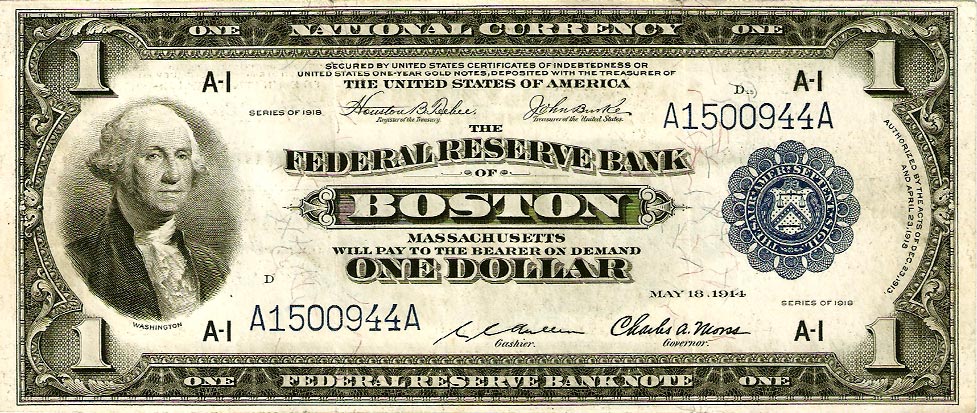
  
Known also as National Currency, the Series 1918 Federal Reserve Bank Note measures 7 3/8 by 3 1/8 inches and displays a portrait of George Washington on the obverse. The note has the blue seal and serial numbers that are more typically found on Silver Certificates, but the obligation clause states, "SECURED BY UNITED STATES CERTIFICATES OF INDEBTEDNESS OR UNITED STATES ONE-YEAR GOLD NOTES, DEPOSITED WITH THE TREASURER OF THE UNITED STATES OF AMERICA" and the note indicates that the issuing bank will "PAY TO THE BEARER ON DEMAND ONE DOLLAR." The obverse also states, "AUTHORIZED BY THE ACTS OF DEC. 23, 1913 AND APRIL 23, 1918." Despite the fact that this is a Series 1918 note, which is clearly marked, the obverse of the note also bears the date May 18, 1914.
Issued by the Federal Reserve Bank of Boston, Massachusetts, this note features signatures from both U.S. government officials and bank officials.
The reverse of the note features an engraved vignette titled Eagle with Flag, along with a redemption clause that reads, "THIS NOTE IS RECEIVABLE AT PAR IN ALL PARTS OF THE UNITED STATES IN PAYMENT OF ALL TAXES AND EXCISES AND ALL OTHER DUES TO THE UNITED STATES EXCEPT DUTIES ON IMPORTS AND ALSO FOR ALL SALARIES AND OTHER DEBTS AND DEMANDS OWING BY THE UNITED STATES TO INDIVIDUALS CORPORATIONS AND ASSOCIATIONS WITHIN THE UNITED STATES EXCEPT INTEREST ON PUBLIC DEBT."
Note that, since these notes were issued by individual banks, the scarcity and value of these notes depends greatly on the issuing bank as well as their condition.
|
|
Series 1923 One Dollar Silver Certificate
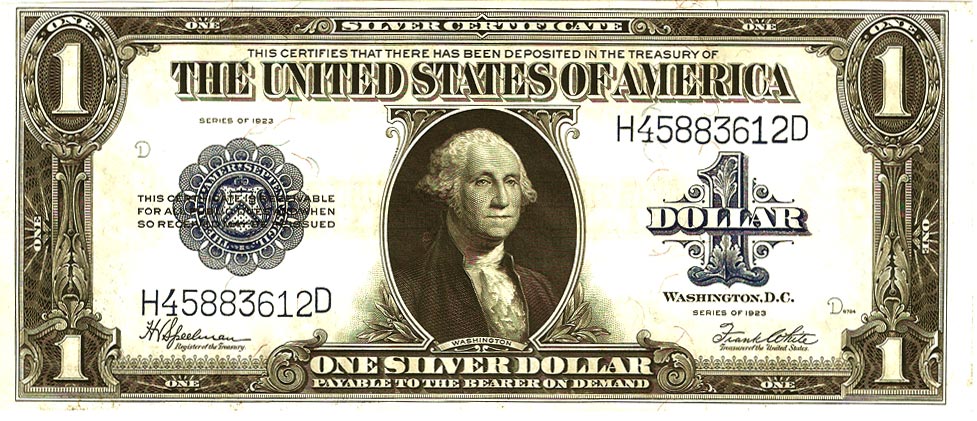
 
The Series 1923 $1 Silver Certificate was the last large-sized $1 Silver Certificate ever designed. Measuring 7 3/8 by 3 1/8 inches, it was nicknamed "Horseblanket" due to its size and bears the distinctive blue seal and serial numbers that mark it as a genuine Silver Certificate. The obverse of the note features a central portait of George Washington and bears a redemption clause that states, "THIS CERTIFICATE IS REDEEMABLE FOR ALL PUBLIC DUES AND WHEN SO RECEIVED MAY BE REISSUED." Also displayed on the obverse is the phrase, "THIS CERTIFIES THAT THERE HAS BEEN DEPOSITED IN THE TREASURY OF THE UNITED STATES OF AMERICA ONE SILVER DOLLAR PAYABLE TO THE BEARER ON DEMAND."
The Reverse simply displays the phrase, "THE UNITED STATES OF AMERICA ONE DOLLAR."
|
|
Series 1923 One Dollar Legal Tender Note

 
The Series 1923 $1 Legal Tender Note (a.k.a United States Note) was the last large-sized $1 Legal Tender Note ever designed. Measuring 7 3/8 by 3 1/8 inches, it was nicknamed "Horseblanket" due to its size and bears the distinctive red seal and serial numbers that mark it as a genuine Legal Tender Note. The obligation clause on the obverse reads, "THIS NOTE IS A LEGAL TENDER AT ITS FACE VALUE FOR ALL DEBTS PUBLIC AND PRIVATE EXCEPT DUTIES ON IMPORTS AND INTEREST ON THE PUBLIC DEBT." The redemption clause reads "THE UNITED STATES OF AMERICA WILL PAY TO THE BEARER ON DEMAND ONE DOLLAR."
The Reverse simply displays the phrase, "THE UNITED STATES OF AMERICA ONE DOLLAR."
|
|
Series 1928A "Funnyback" One Dollar Silver Certificate
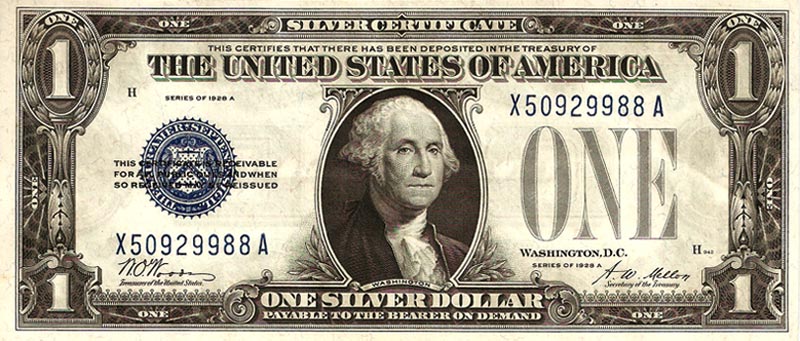
 
1928 marked the release of the first small size currency (all prior issues were much larger in size). The reverse design on this short-lived series was very plain and the notes are affectionately referred to as "Funny Back" notes because they resemble play money. The note bears the distinctive blue seal and serial numbers that mark it as a genuine Silver Certificate. The obligation clause on the obverse reads, "THIS CERTIFICATE IS REDEEMABLE FOR ALL PUBLIC DUES AND WHEN SO RECEIVED MAY BE REISSUED." The redemption clause reads, "THIS CERTIFIES THAT THERE HAS BEEN DEPOSITED IN THE TREASURY OF THE UNITED STATES OF AMERICA ONE SILVER DOLLAR PAYABLE TO THE BEARER ON DEMAND."
The Reverse simply displays the phrase, "THE UNITED STATES OF AMERICA ONE DOLLAR."
|
|
Series 1928A "Funnyback" One Dollar Legal Tender Note
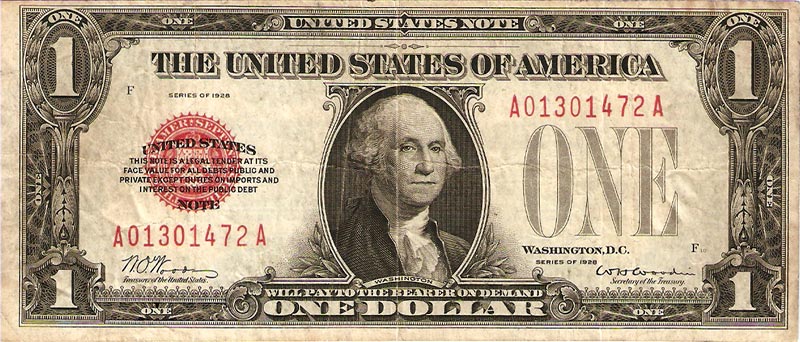
 
1928 marked the release of the first small size currency (all prior issues were much larger in size). The reverse design on this short-lived series was very plain and the notes are affectionately referred to as "Funny Back" notes because they resemble play money. The note bears the distinctive red seal and serial numbers that mark it as a genuine Legal Tender Note. The obligation clause on the obverse reads, "THIS NOTE IS A LEGAL TENDER AT ITS FACE VALUE FOR ALL DEBTS PUBLIC AND PRIVATE EXCEPT DUTIES ON IMPORTS AND INTEREST ON THE PUBLIC DEBT." The redemption clause reads "THE UNITED STATES OF AMERICA WILL PAY TO THE BEARER ON DEMAND ONE DOLLAR."
The Reverse simply displays the phrase, "THE UNITED STATES OF AMERICA ONE DOLLAR."
|
|
Series 1934 "Funnyback" One Dollar Silver Certificate (Transitional)
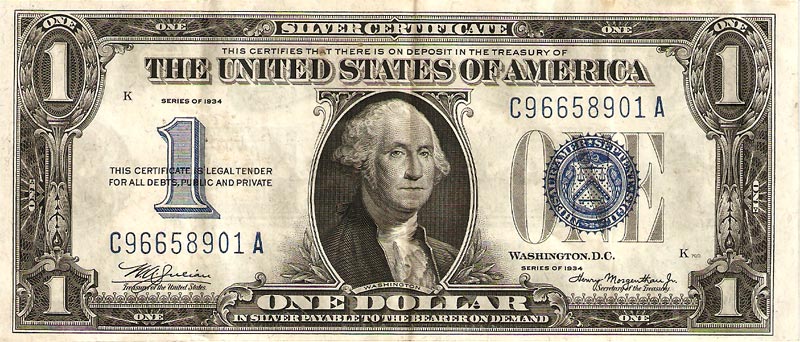
 
The Series 1934 One Dollar Silver Certificate was only produced for one year and is considered a "transitional" design since the reverse bears the same design as the previous "funnyback" Series 1928 Silver Certificates, whereas the obverse has a new design. The redemption clasue on the obverse now reads, "THIS CERTIFICATE IS LEGAL TENDER FOR ALL DEBTS, PUBLIC AND PRIVATE," whereas the redemption clause still reads, "THIS CERTIFIES THAT THERE HAS BEEN DEPOSITED IN THE TREASURY OF THE UNITED STATES OF AMERICA ONE SILVER DOLLAR PAYABLE TO THE BEARER ON DEMAND."
A slightly modified version of this new design on the obverse was combined with a totally new design on the reverse the following year.
|
|
Series 1935E One Dollar Silver Certificate
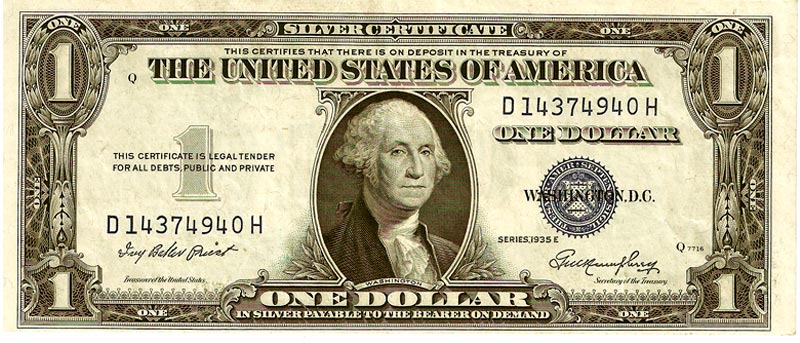
 
The obverse of the Series 1935 One Dollar Silver Certificate was largely unchanged from that of the 1934 Series, but the reverse was completely redesigned with a design that has been used for all one dollar bills ever since.
|
|
Series 1935A WWII North Africa One Dollar Emergency Note
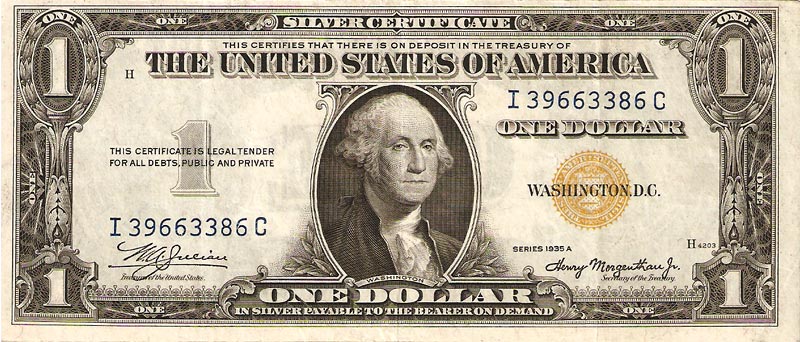
 
This special 1935A $1 Silver Certificate was printed for use during Operation Torch (the British–American invasion of French North Africa in World War II during the North African Campaign, starting on 8 November 1942). Unlike the standard silver certificates that bear a distinctive blue Treasury seal, these notes have a special yellow Treasury seal to assure instant recognition (and devaluation) in the event of defeats by the enemy, or enemy capture of large quantities of cash. These are also known as "yellow seal" Silver Certificates.
|
|
Series 1935A WWII Hawaii One Dollar Emergency Note

 
This special 1935A $1 Silver Certificate was printed for use in Hawaii after the Japanese attack on Pearl Harbor. Unlike the standard silver certificates that bear a distinctive blue Treasury seal, these notes have a special brown Treasury seal to assure instant recognition (and devaluation) in the event of defeats by the enemy, or enemy capture of large quantities of cash. In addition, the word "HAWAII" is overprinted on the obverse and reverse. These are also known as "brown seal" Silver Certificates.
|
|
Series 1957A One Dollar Silver Certificate
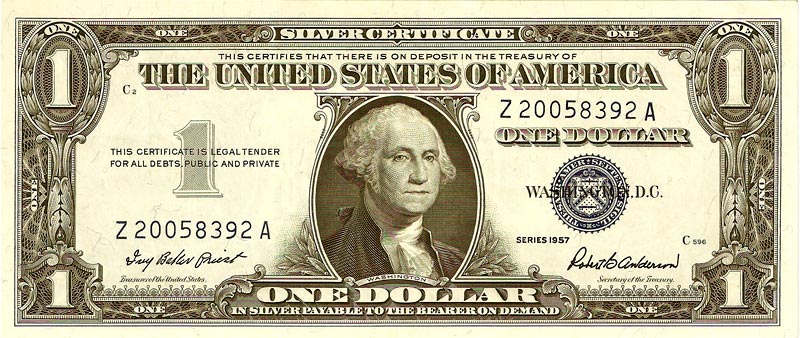
 
The Series 1957 $1 Silver Certificate was the last of the small-size Silver Certificates issued. The obverse and reverse were the same as that used for the Series 1935 Silver Certificate, except that the words "IN GOD WE TRUST" were added to the reverse. Once redeemable for silver coin or bullion, these notes and the redemption option were discontinued by Act of Congress in 1963.
|
|
Series 1963A One Dollar Federal Reserve Note
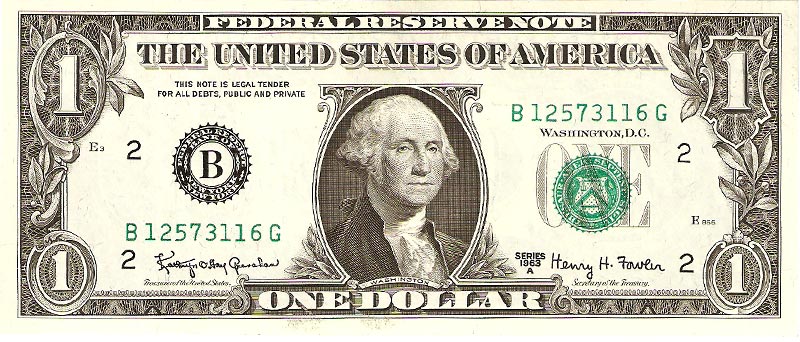


The Series 1963 $1 Federal Reserve Note was the first $1 note to feature a green Treasury Seal along with the revised obligation, "THIS NOTE IS LEGAL TENDER FOR ALL DEBTS, PUBLIC AND PRIVATE" on the obverse. These notes also carried a black seal on the left bearing the identity of the Federal Reserve Bank of issuance (the regional seal is a design facet unique to Federal Reserve Notes, because almost all other types of notes were issued directly by the U.S. Treasury). Note that, as of 1963, the words "PAYABLE TO THE BEARER ON DEMAND" were removed from all newly issued Federal Reserve notes to indicate the fact that U.S. currency was now considered fiat money, unbacked by any physical asset. As of this writing (2015), the design of the $1 Federal Reserve Note has remained unchanged from 1963, which makes it unique among all U.S. currency printed today.
|
|
One Dollar | Two Dollar | Five Dollar | Ten Dollar | Twenty Dollar | Fifty Dollar | Hundred Dollar | Miscellaneous
|
|
|